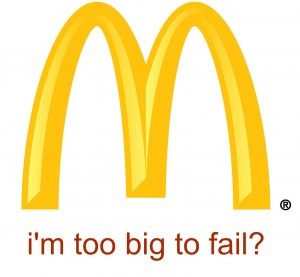The views expressed here are solely those of the author, and do not reflect the views of Food+Tech Connect.
The “too-big-to-fail” theory asserts that certain financial institutions are so large and so interconnected that their failure would be disastrous to the economy. The original term “too big to fail” was popularized by U.S. Congressman Stewart McKinney in a famous 1984 Congressional hearing, discussing the Federal Deposit Insurance Corporation’s intervention with Continental Illinois. Most recently, Federal Reserve Chair Ben Bernanke also defined the term in 2010:
“A too-big-to-fail firm is one whose size, complexity, interconnectedness, and critical functions are such that, should the firm go unexpectedly into liquidation, the rest of the financial system and the economy would face severe adverse consequences.”
Until now, this assumption has only been applied through the governance lens when dealing with financial institutions. If you break down what “too big to fail” actually measures, however, it’s a business model and/or a company that’s so important to economic activity that they should become recipients of beneficial financial and economic policies from governments or central banks. Within this context, this theory could actually be applied across all business sectors and used to evaluate the impact of an unexpected market breakdown or failure.
Let’s take one of America’s favorite past times, eating, as an example. America is the home to some of the biggest food companies in the world. McDonald’s, Subway and Starbucks alone take in over $60 billion in yearly sales in the U.S. McDonald’s global sales numbers have them taking in nearly $45 billion outside of our borders. Without breaking down these mammoth numbers, it’s easy to see how much leverage these companies have.
Let’s just hypothesize some of the inherent risks these companies have on our economic system:
- These companies generate severe moral hazard in our communities. In many food deserts, fast food options are the only quick and reliable source of nutrition for many inner city families. If an institution failed that had a major footprint and provided daily meals to millions of citizens, this would cause a massive disruption in our food ecosystem. This moral premise inadvertently would disturb local labor opportunities, in which food retail is a high percentage of employment.
- They create an uneven playing field between big and small business. Companies such as McDonald’s and Burger King have developed a price floor model (dollar menus) that have driven these companies to sell products at a loss, which they can functionally maintain through the abundance of add-on options and upgrades. Most smaller businesses cannot afford to mimic this, thus forcing them to keep higher prices and not compete in this demographic. The incentive to grow that “too-big-to-fail” provides, increases risk and inadvertently raises the market share of these
companies artifically, to the detriment of standard economic efficiency as well as financial stability in inner city communities. The USDA has provided an interactive map that showcases the dramatic affect that fast food retail has had on the welfare and well being of these communities, illustrating an overall lack of access to differentiated food options. - The failure of a company the size of Subway or McDonald’s would significantly impact thousands of business partners and disrupt financial markets, impeding credit flows and hurting consumer confidence. While the failure of smaller, less interconnected companies, would not have effects on the stability of certain communities and the financial system as a whole.
Concerns surrounding the role large food companies play in the ethical, environmental and societal impacts of food production and consumption have been documented fairly regularly. But I’m curious about the economic impact and future concern around how interconnected these companies are and the fragile ‘commodity’ of food. When big companies leverage only a few suppliers or manufacturers, they can control the market for that item and create a very tight and guarded buying structure. For many of these firms, food acts as commodity, not a source of nourishment. For example, shortly after McDonalds’s cut the Angus burgers from U.S. menus U.S. beef prices hit a 10-year high, because they have such a big wedge in the beef commodity market.
When a company grows to a certain scale, one of its major revenue drivers is new store openings. Everything else on the P&L generally falls in line with the ability to rapidly develop more unit locations. Unfortunately, when these companies are not driving that metric sufficiently, there’s disruption that ripples down through the web of distributors, vendors and shareholders.
Don’t get me wrong, large business has provided millions of people across our country the opportunity to live a meaningful and fulfilling life. The problem arises when these companies grow to support infrastructural need rather than consumer need, inseminating artificial revenue and economic instability into many of our country’s communities. My company, Panera Bread, recognizes this polarizing challenge, which is one of the reasons it launched Panera Cares, to help fight food insecurity and fill bellies in a way that provides self esteem to the less fortunate while generating local economic activity.
In summary, big business has the responsibility to not only drive profit to their shareholders, but to interpret the current climate of their customers well being. The more large companies isolate and curb interference from potential future competitors, the more it hurts local economies and the future of food in our country. Legacy techniques and current strangleholds on distribution can be disrupted by people making smart choices and fortunately, the traditional retailers are starting to take notice. The end goal here is to drive these large companies into making the right social and economic decisions that ultimately put them into a competitive advantage. Once that happens, a tidal wave of progress will be made.






